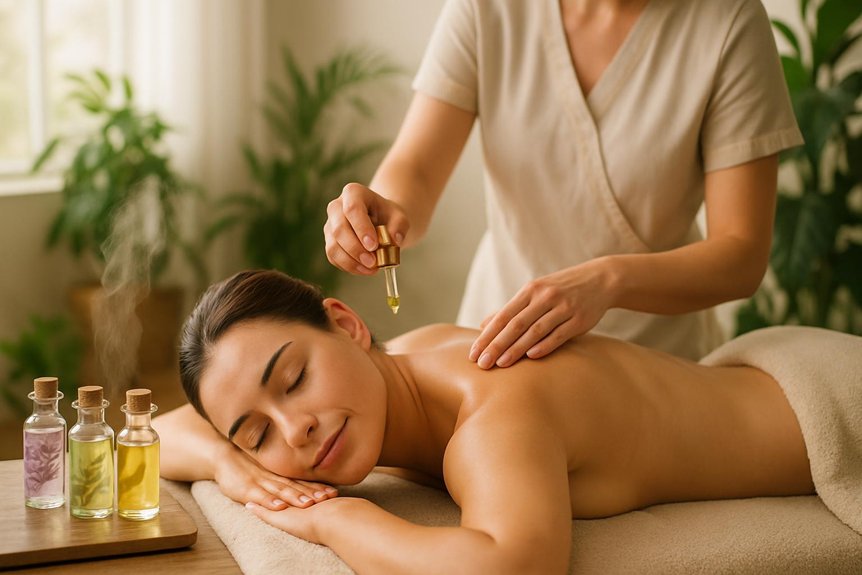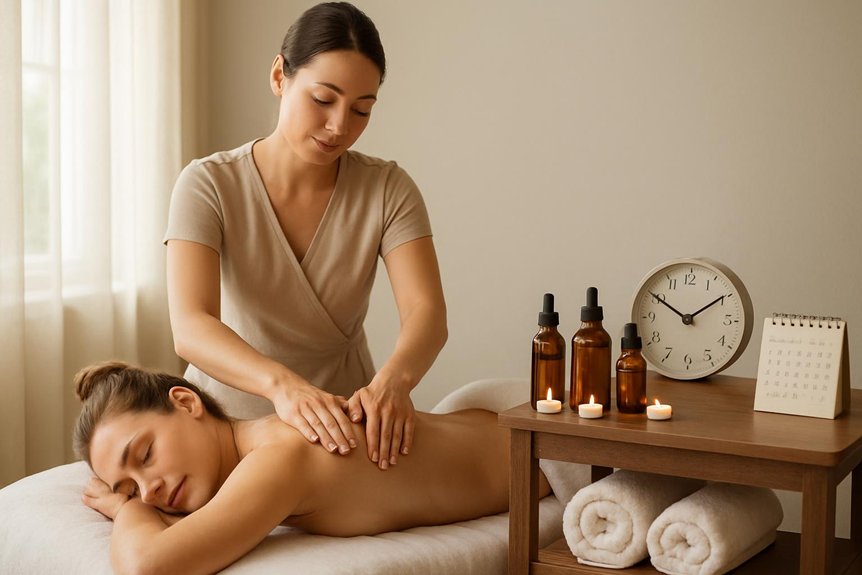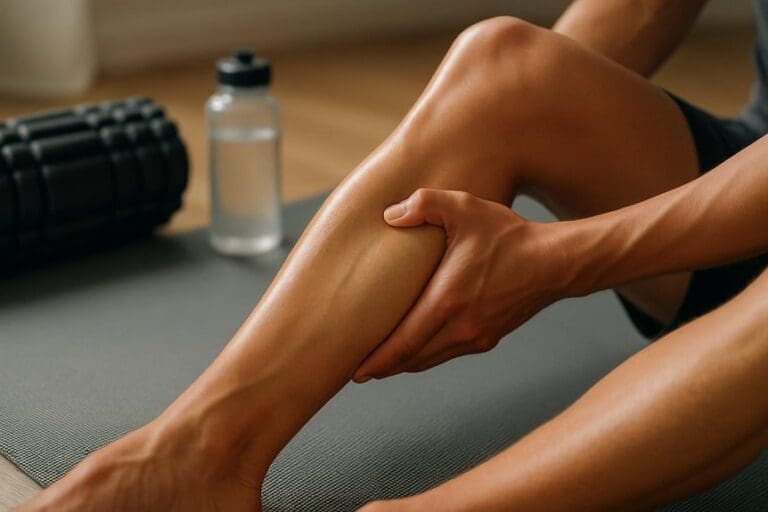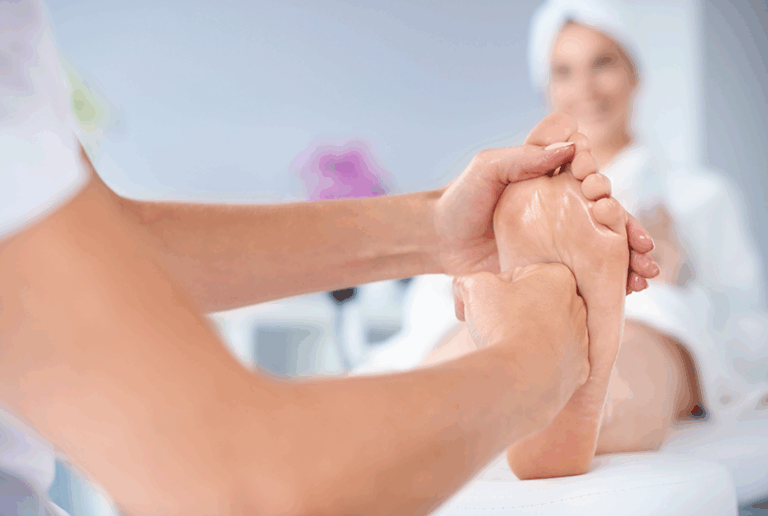Most adults can have essential oil massage weekly for short-term goals, then shift to biweekly or monthly maintenance. Stress, sleep, and mood concerns often respond to weekly sessions for 3–4 weeks; muscular tension may need 4–6 weekly visits before tapering. Health status, sensitivities, and response to prior treatments guide spacing. After illness, vaccinations, or medication changes, wait 48 hours to 2 weeks. Pregnant or breastfeeding clients should seek medical advice. Signs like soreness or irritation suggest longer intervals. Additional guidance follows.
Understanding Essential Oil Massage and Its Benefits

What makes aromatherapy massage distinct is its blend of skilled touch with the therapeutic properties of essential oils. At Spa & Massage, therapists combine gentle to moderate pressure with carefully selected, diluted essential oils to support relaxation, ease muscular tension, and calm the nervous system.
Evidence suggests aromatherapy may reduce perceived stress, improve sleep quality, and modulate pain through olfactory pathways and parasympathetic activation.
In our clinics, therapists tailor oils—such as lavender for soothing, citrus for uplift, or eucalyptus for clearer breathing—based on a detailed consultation and any sensitivities. They use slow, flowing techniques to encourage circulation and quiet overactive muscles, inviting a deeper sense of comfort.
Clients often notice softer breathing, a settled mind, and lingering calm, supported by clear aftercare guidance and hydration advice. Like essential oil massage, the healing power of reflexology can also provide holistic benefits through intentional touch and pressure.
Factors That Influence How Often You Should Book
Booking frequency is best guided by individual health status—such as chronic pain, pregnancy, allergies, or sensitivity to essential oils—as these factors may warrant tailored session intervals and oil selections.
Lifestyle demands and stress load also matter; clients with high-pressure schedules or poor sleep often benefit from more regular essential oil massage to support nervous-system regulation.
At Spa & Massage, therapists assess health history and current stress indicators to recommend an appropriate cadence, typically adjusting from weekly to monthly based on response and goals.
Personal Health Considerations
How do individual health profiles shape the ideal frequency for essential oil massage? Spa & Massage approaches this with clinical care and tender attention.
Medical conditions guide cadence: chronic pain or osteoarthritis may benefit from weekly sessions during flare-ups, tapering to fortnightly for maintenance.
Cardiovascular history, diabetes, and autoimmune conditions warrant cautious pacing—often every 2–4 weeks—while monitoring post-session responses. Pregnancy requires trimester-appropriate scheduling; in our clinics, certified therapists typically recommend every 2–3 weeks with gentle pressure and obstetric-safe blends.
Skin sensitivity and allergies determine oil selection and spacing. Our therapists perform patch testing and often begin with lighter dilutions, adjusting frequency as tolerance is confirmed.
Medication use, recent illness, and surgery timelines also matter; our team coordinates with medical guidance to time sessions safely and effectively.
Lifestyle and Stress Levels
Alongside medical considerations, day-to-day demands and stress exposure strongly influence essential oil massage cadence. Individuals in high-pressure roles, shift work, or caregiving often benefit from weekly sessions to stabilise sleep, mood, and muscle tension.
Those with moderate stress may sustain results with sessions every 2–3 weeks, while low-stress routines can maintain wellbeing monthly.
At Spa & Massage in London, therapists assess workload patterns, commute strain, screen time, and recovery habits.
They then propose a cadence and blend calming essential oils—typically lavender, bergamot, and frankincense in balanced dilutions—to match nervous-system needs.
Clients under chronic stress are guided to combine massage with breathwork and gentle stretching after sessions.
If stress spikes—deadlines, travel, exams—frequency can be temporarily increased, then tapered as equilibrium returns.
Recommended Frequencies for Common Wellness Goals
For most clients, essential oil massage frequency is guided by goals, health status, and response to treatment, and our therapists at Spa & Massage tailor schedules accordingly.
For stress relief and better sleep, weekly sessions for 3–4 weeks, then every 2–3 weeks, maintain gains.
For persistent muscular tension, weekly for 4–6 weeks, then fortnightly, supports tissue recovery alongside gentle mobility work.
For mood support and emotional balance, weekly or fortnightly provides consistent regulation of the nervous system.
For general wellbeing, a monthly session sustains calm and resilience.
For pre-event calming or travel recovery, a single focused session 24–72 hours beforehand is effective.
In our clinics, oils and pressure are adjusted each visit, and progress is reviewed to refine cadence and maintain results.
Safety Considerations and When to Space Sessions Out

Although essential oil massage is generally gentle, safe scheduling depends on individual health, skin sensitivity, and recent medical events.
At Spa & Massage, therapists encourage spacing sessions if there has been illness, fever, active skin irritation, or a new medication, allowing at least one to two weeks to observe responses.
Those with asthma, allergies, low blood pressure, or migraines may benefit from longer intervals while tracking triggers. After vaccinations, dental surgery, or significant exercise-induced soreness, waiting 48–72 hours helps reduce overstimulation.
Clients who are pregnant, breastfeeding, or managing chronic conditions should seek medical advice and disclose details at booking; therapists then adjust pressure, areas treated, and timing.
If post-session fatigue, headaches, or rash occur, they recommend pausing until symptoms settle before rebooking.
How We Personalise Essential Oil Blends and Session Plans
Before any essential oil massage begins, Spa & Massage therapists complete a brief consultation to clarify goals, health history, scent preferences, and any sensitivities. From there, they design a bespoke blend and rhythm for the session. Dilutions are evidence-based—typically 1–2% for general relaxation, lighter in pregnancy, higher only when appropriate.
Essential oils are selected for desired effects: lavender and Roman chamomile for unwinding, bergamot for emotional lift, frankincense for grounded breathing, eucalyptus for clearer airways. Carrier oils are chosen for skin feel—light grapeseed for glide, richer sweet almond for cocooning warmth.
Session plans align with aims and frequency: slower, enveloping strokes for deep rest; focused neck–shoulder work for desk strain; breath-led techniques for emotional ease. Personalisation evolves with feedback, building reassuring continuity.
Signs You May Need to Adjust Your Schedule
Clients may benefit from adjusting frequency if they notice persistent post‑massage soreness beyond 24–48 hours, as this can indicate excessive pressure or insufficient recovery time.
Fluctuating energy levels—such as feeling unusually fatigued after sessions or overstimulated—also suggest the cadence or oil selection may need review.
If skin irritation or heightened sensitivity to scent occurs, Spa & Massage therapists recommend pausing, patch-testing blends, and modifying oils or spacing sessions accordingly.
Persistent Post-Massage Soreness
While mild tenderness after an essential oil massage can be normal, persistent soreness that lasts beyond 24–48 hours may indicate the body isn’t fully recovering between sessions.
From an evidence-based perspective, prolonged discomfort often reflects overworked tissues, insufficient hydration, or sensitivity to pressure or essential oils.
At Spa & Massage, therapists encourage clients to track soreness duration and intensity; a pattern beyond two days suggests extending time between appointments or adjusting pressure, areas of focus, and oil blends.
In our clinics, gentler techniques, shorter sessions, and anti-inflammatory essential oils (such as lavender or chamomile) are commonly recommended.
Clients are guided to hydrate, apply warm compresses, and perform light stretching.
If soreness persists despite modifications, we advise consulting a GP.
Care should feel nourishing—never depleting—so frequency should honor recovery.
Fluctuating Energy Levels
Occasionally feeling energised after an essential oil massage and unusually fatigued after another can signal that the current schedule or treatment intensity needs refining. Fluctuating energy is common when nervous system tone, sleep debt, and stress load shift between sessions.
In our clinics, therapists observe that marked post-treatment fatigue beyond 24 hours may indicate sessions are too frequent, pressure is too deep, or essential oil blends are overly sedative. Conversely, brief clarity followed by a crash often reflects dehydration or inadequate post-session nutrition.
Spa & Massage recommends tracking energy for 48 hours after each visit, noting sleep, caffeine, cycle phases, and training volume. If swings persist, clients typically benefit from extending intervals to 2–3 weeks, softening pressure, or selecting balancing blends such as lavender-bergamot.
Gentle movement, water, and unhurried recovery enhance stability.
Skin or Scent Sensitivity
Beyond energy patterns, the skin and sense of smell often provide early feedback that aromatherapy frequency or blends need adjustment. Mild redness lasting beyond 24 hours, tightness, or itch that appears after sessions suggests dilution or interval changes are needed. A sudden aversion to a familiar aroma, dizziness, or a lingering headache can also indicate sensory overload.
At Spa & Massage, therapists patch-test new blends on the forearm and use conservative dilutions (typically 1–2% for relaxation, lower for sensitive skin). If reactions arise, they recommend spacing sessions to every two to three weeks, simplifying to one or two gentle oils, or switching to neutral carrier-only massage before reintroducing aromas.
Clients are invited to share subtle shifts; careful pacing preserves comfort while sustaining therapeutic benefit.
Aftercare Between Sessions to Prolong the Benefits
How can clients extend the calm and therapeutic effects of an essential oil massage once they leave the clinic? Spa & Massage recommends simple, evidence-informed steps that preserve relaxation and support the body’s natural recovery.
Hydration is key: drinking water helps circulation and metabolic clearance after essential oil application. Gentle movement—such as a slow evening walk or light stretching—maintains joint comfort without overstimulating the nervous system.
Clients are advised to keep the infused oils on the skin for several hours. In our clinics, therapists suggest a warm (not hot) shower later to avoid stripping aromatic compounds prematurely.
Prioritising sleep, dim light, and unhurried breathing can stabilise parasympathetic tone. Our therapists recommend avoiding heavy alcohol, intense workouts, and long hot baths immediately post-treatment.
A brief self-massage using a simple, skin-safe carrier oil can sustain softness and scent.
Building a Sustainable Routine With Spa & Massage Therapists
Recovering peacefully after a session is only part of the picture; consistent benefits come from a plan that fits a client’s lifestyle and goals. At Spa & Massage, therapists co-create a schedule—often weekly for acute stress, then tapering to fortnightly or monthly for maintenance—guided by evidence on cumulative effects of touch and essential oils.
They assess sleep, workload, and recovery signals, adjusting cadence and blend selection accordingly. In our clinics, bespoke aromatherapy—lavender for sleep, bergamot for tension, eucalyptus for clarity—is paired with measured pressure to avoid overstimulation.
Clients are encouraged to track outcomes (mood, pain, energy) to refine frequency. Convenient London locations support adherence, and packages make consistency practical. The aim is sustainable relief: steady nervous-system regulation, softer muscle tone, and a calmer, more intimate pace of living.
Conclusion
In the end, clients discover the ideal aromatherapy schedule isn’t dictated by candles, but by evidence: stress levels, goals, and how their body responds. Ironically, the best routine often feels pleasantly ordinary—regular, tailored sessions spaced to maintain benefits without excess. With personalised oil blends, sensible pacing, and clear aftercare, they gain consistent relief rather than quick fixes. When tension resurfaces, they know—book again. Sustainable wellbeing, it turns out, is less about indulgence and more about informed, repeatable care.



